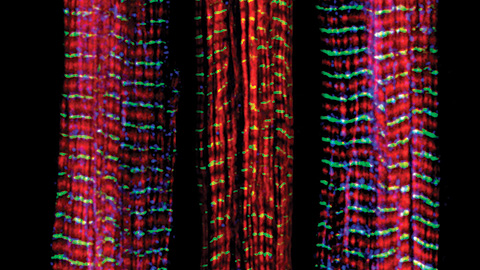World Meningitis Day
Meningitis affects 1 million people globally each year. The disease, which can kill a person in 24 hours, is caused by inflammation of the brain and spinal cord. Many types of bacteria, and some viruses and fungi, cause meningitis. Some types can be prevented with safe and effective vaccines; others cannot. The organizers of World Meningitis Day (April 24) plan to highlight the many causes of meningitis. The ASBMB is observing the day by sharing articles on various meningitis-causing pathogens.
Fungal meningitis
Cryptococcal meningitis is responsible for an estimated 15 percent of all AIDS-related deaths. Antifungals, which some immunocompromised patients must take for life to prevent meningitis, often target biosynthetic pathways including lipid biogenesis. A recent study in the Journal of Lipid Research undertook a comprehensive catalogue of lipids in various strains of Cryptococcus and described a number of possible future antifungal targets. Read the work here.
A paper in the Journal of Biological Chemistry described the structure of an enzyme called ADS lyase from Cryptococcus neoformans, which may be another antifungal drug target. Read the article here.
Viral Meningitis
Herpes viruses can induce meningitis. An article in Molecular & Cellular Proteomics introduced a database of protein-protein interactions within herpesvirus-1. The database predicted some hitherto unknown interactions within the virus, and may in the future be used to organize proteomics findings and identify new drug targets. Access the open-access article here or the database here.
Viral meningitis sometimes arises as a fatal complication of hand, foot and mouth disease caused by enterovirus 71. A paper in the Journal of Biological Chemistry described an unexpected mechanism by which the virus blocks cell signaling to circumvent the immune system’s antiviral response. Read more here.
Bacterial meningitis
Vaccination against Neisseria meningitidis, a leading cause of bacterial meningitis, can be costly because researchers must grow the bacterium in culture to isolate oligosaccharide antigens. An article in the Journal of Biological Chemistry reports the development of enzyme-based tools to make oligosaccharides in vitro, which could someday lower the cost of vaccine production.
Trafficking of N. meningitidis lipoproteins to the outer bacterial membrane determines which antigens are available for immune recognition. A paper in Molecular & Cellular Proteomics investigated how N. meningitidis and other Gram-negative bacteria transport these proteins. Read the paper here.
Enterococcus faecalis is a commensal organism in the gastrointestinal tract, but can form dangerous biofilms on implanted medical devices that can lead to complications like bacterial meningitis. A paper in Molecular & Cellular Proteomics identified markers of biofilm formation ability that might help develop drugs to target biofilm formation and prevent infection.
Bacteria from the birth canal can be associated with life-threatening meningitis in newborns. Fortunately for infants, oligosaccharides from human milk can protect them from the same neonatal pathogens. A paper in the Journal of Biological Chemistry, accessible here, isolated the human milk oligosaccharide responsible for the protective effect.
Microglia are immune cells in the brain that respond to bacterial meningitis by launching an inflammatory response. A paper in the Journal of Biological Chemistry reported changes in microglial iron transport in response to activation. Find out more here.
The cause of meningitis is sometimes diagnosed by measuring the amount of protein in a spinal tap to find out whether the blood-brain barrier is intact. An article in the Journal of Lipid Research showed that disruption of the barrier raises the level of oxysterol 7-HOCA, along with protein, in the cerebrospinal fluid. Therefore, 7-HOCA could serve as a secondary diagnostic marker for bacterial meningitis and related conditions. Read more here.
Enjoy reading ASBMB Today?
Become a member to receive the print edition four times a year and the digital edition monthly.
Learn moreGet the latest from ASBMB Today
Enter your email address, and we’ll send you a weekly email with recent articles, interviews and more.
Latest in Science
Science highlights or most popular articles

The science of staying strong
Muscles power every movement, but they also tell the story of aging itself. Scientists are uncovering how strength fades, why some species resist it and what lifestyle and molecular clues could help preserve muscle health for life.

Bacteriophage protein could make queso fresco safer
Researchers characterized the structure and function of PlyP100, a bacteriophage protein that shows promise as a food-safe antimicrobial for preventing Listeria monocytogenes growth in fresh cheeses.

Building the blueprint to block HIV
Wesley Sundquist will present his work on the HIV capsid and revolutionary drug, Lenacapavir, at the ASBMB Annual Meeting, March 7–10, in Maryland.

Gut microbes hijack cancer pathway in high-fat diets
Researchers at the Feinstein Institutes for Medical Research found that a high-fat diet increases ammonia-producing bacteria in the gut microbiome of mice, which in turn disrupts TGF-β signaling and promotes colorectal cancer.

Mapping fentanyl’s cellular footprint
Using a new imaging method, researchers at State University of New York at Buffalo traced fentanyl’s effects inside brain immune cells, revealing how the drug alters lipid droplets, pointing to new paths for addiction diagnostics.

Designing life’s building blocks with AI
Tanja Kortemme, a professor at the University of California, San Francisco, will discuss her research using computational biology to engineer proteins at the 2026 ASBMB Annual Meeting.
